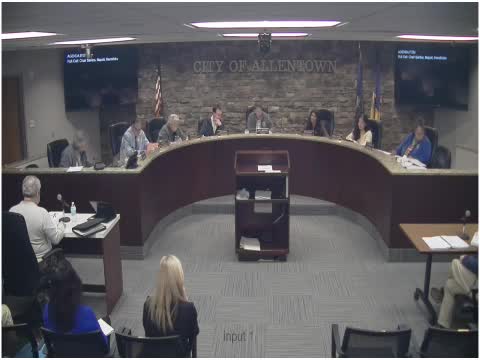Allentown risk staff outline self‑insurance, stop‑loss coverage and recent reimbursements
October 29, 2025 | Allentown City, Lehigh County, Pennsylvania
This article was created by AI summarizing key points discussed. AI makes mistakes, so for full details and context, please refer to the video of the full meeting. Please report any errors so we can fix them. Report an error »

John Ferry, who presented the risk and safety budget now consolidated under HR, described the department's scope and how the city manages claims and benefits.
"We're the we're the insurance company," Ferry said, describing the department's role handling workers' compensation, auto and property claims, and benefits billing.
Ferry said the risk budget is organized into three programs: property and casualty (which includes excess carriers and department salaries), workers' compensation, and benefits (the largest expenditure). He described the city as "self insured" for certain lines and said the city pays claims dollar‑for‑dollar through its processor.
On stop‑loss coverage, Ferry said the city covers the first $255,000 of a claim; amounts above that are reimbursed by the stop‑loss carrier. He reported "$1,400,000 or $1,200,000 in reimbursements already this year," and told the committee the stop‑loss premium is roughly $120,000 annually.
Council members asked for clarification on where risk figures appear in the budget book after account re‑coding; Ferry explained the department's accounts moved under HR pages. The comptroller urged that future budgets consider an analyst to examine claims and medical‑cost data to unlock savings, noting the three‑person department is stretched.
"We're the we're the insurance company," Ferry said, describing the department's role handling workers' compensation, auto and property claims, and benefits billing.
Ferry said the risk budget is organized into three programs: property and casualty (which includes excess carriers and department salaries), workers' compensation, and benefits (the largest expenditure). He described the city as "self insured" for certain lines and said the city pays claims dollar‑for‑dollar through its processor.
On stop‑loss coverage, Ferry said the city covers the first $255,000 of a claim; amounts above that are reimbursed by the stop‑loss carrier. He reported "$1,400,000 or $1,200,000 in reimbursements already this year," and told the committee the stop‑loss premium is roughly $120,000 annually.
Council members asked for clarification on where risk figures appear in the budget book after account re‑coding; Ferry explained the department's accounts moved under HR pages. The comptroller urged that future budgets consider an analyst to examine claims and medical‑cost data to unlock savings, noting the three‑person department is stretched.
View full meeting
This article is based on a recent meeting—watch the full video and explore the complete transcript for deeper insights into the discussion.
View full meeting